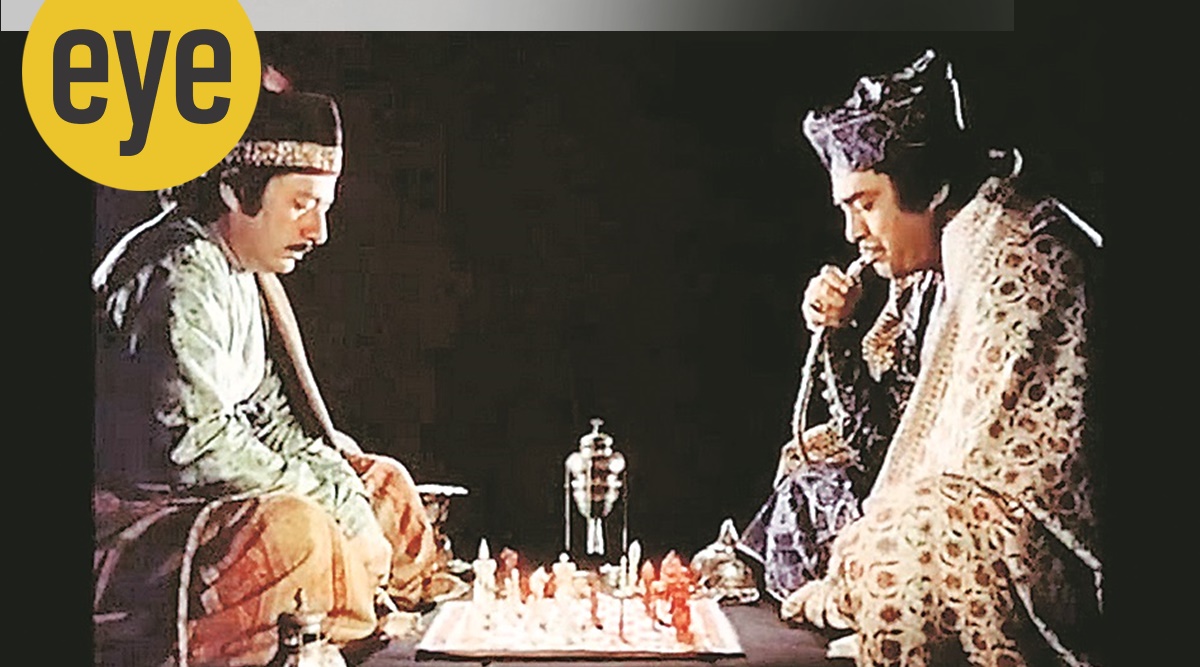 Check mate: A still from Ray’s Shatranj Ke Khilari
Check mate: A still from Ray’s Shatranj Ke Khilari Wajid Ali Shah ka samay thha. Lucknow vilasiata ke rang mein dooba hua thha, ameer, gareeb sab…” (It was Wajid Ali Shah’s time. Lucknow was drowning in decadence, rich, poor, everybody…).
Munshi Premchand’s classic 1924 short story Shatranj Ke Khilari, published first in the magazine Madhuri, opens with these succinct sentences. With swift, deft strokes, the author builds a portrait of the decaying nawaabi culture, which was so much a part of the 1856 Lucknow — from the commonplace rooster fights and kite-flying, to the Kathak mehfils in Nawab Wajid Ali Shah’s ornate palace. The British troops are advancing, the Resident has delivered an ultimatum to the hapless ruler of Lucknow, and the writing is visible on the crimson paan-stained walls of one of the most beautiful cities of the Awadh region. But who’s bothered? Not our chess addicts, Mirza Sajjad Ali and Mir Roshan Ali, oblivious to their world crumbling around them.
It’s fitting that the first Hindi feature Satyajit Ray made is based on Premchand’s story, with its sharp recounting of time and place. Ray, whose centenary we are celebrating this month, expands on characters and events in his nearly two-hour film, but the focus remains on the two khilaris (players) as they go through their day, arranging the chess pieces, keeping their countless retainers on the run with a non-stop supply of hookahs and freshly-made paans, as well as keeping their wives at bay.
Sanjeev Kumar as Mirza and Saeed Jaffrey as Mir are the perfect couple, as they joust through the days and nights that follow: is there a hint of homoeroticism in the way they come apart and fit together? Or is chess, quite simply, better than sex? It would appear so, seeing Shabana Azmi’s doe-eyed desperation — as the lonely wife of Mirza, she tries unsuccessfully to get her husband back to her arms. In Mir’s haveli, other kinds of games are afoot: his wife, played by the sparkly Farida Jalal, is having it on with the young, handsome Farooq Shaikh, and the sequence in which the duo nearly gets caught is an abiding delight.
I revisited the film again this week, and found a few Bollywood flourishes I had missed before. A few of Sanjeev Kumar’s expressions are familiar from his other movies. And Amjad Khan, as the weak, effete Wajid Ali Shah, is spot on much of the time, but in one sequence, where he comes across like a sulky baby rather than a powerful ruler, he sounds exactly as he had as Gabbar Singh in Sholay, which had made him famous two years earlier, in 1975. Jaffrey is perfect as is the narration by Amitabh Bachchan.
It’s hard to pick favourites from Ray’s expansive filmography. Among the ones I return to are the Apu Trilogy (1956-1959), Devi (1960), Mahanagar (1963), Charulata (1964), Nayak (1966), Aranyer Din Ratri (1970), the Felunath mysteries (1974-1979), Hirak Rajar Deshe (1980). But for sheer prescience, there’s nothing to beat Shatranj Ke Khilari: the country was then laid bare to a relentless enemy, as it is now.
- The Indian Express website has been rated GREEN for its credibility and trustworthiness by Newsguard, a global service that rates news sources for their journalistic standards.

 Continue with Facebook
Continue with Facebook Continue with Google
Continue with Google
